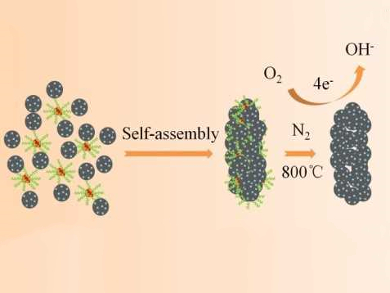Heteroatom-doped nanoporous carbon materials (NCMs) have been widely researched and used in catalysis, drug delivery, separation, energy conversion/storage, and many other fields. However, the complicated fabrication processes required still limits their development.
Xiaojin Li, Wenqi Liu, Qingdao Institute of Bioenergy and Bioprocess Technology, Chinese Academy of Sciences, and colleagues have developed a simple and green self-assembly synthesis method that allows the synthesis of low-cost, nanoporous, mulberry-like Fe/N/S-doped carbon materials. An Fe2+-mediated polymerization of dopamine (DA) and a further interaction with micelles of the triblock copolymer F127 induce the formation of mulberry-like structures (pictured right).
The prepared catalyst has numerous active sites, such as sp2 carbon atoms, graphitic and pyridinic nitrogen atoms, Fe-Nx sites, and C–S–C groups. The atomic iron content, the highly effective N/S-doping, and the porous structure synergistically enhance the catalyst’s oxygen reduction reaction (ORR) activity. The obtained catalyst has a high Brunauer-Emmett-Teller (BET) surface area of 913.2 m2 g–1 and shows an improved activity, stability, and methanol resistance compared with a commercial Pt/C catalyst for the ORR.
- Self-Assembly Synthesis of Mulberry-like Fe/N/S-Doped Highly Porous Carbon Materials: Efficient and Stable Catalysts for Oxygen Reduction Reaction,
Wenqi Liu, Dongyan Xu, Xiaojin Li,
ChemNanoMat 2018.
https://doi.org/10.1002/cnma.201800514




